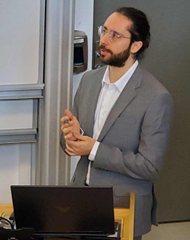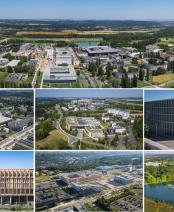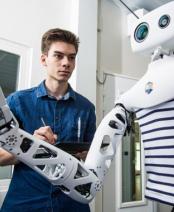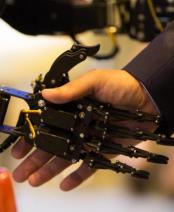Cognitive disorders: diagnosis using waves

More than just a research tool, electroencephalograms (EEGs) combined with artificial intelligence could become a simple way to detect neurocognitive disorders, also known as vascular dementia. During his thesis, Maxime Bedoin used EEG to differentiate these disorders (caused by small infarcts in the cerebral vascular network) from Alzheimer's disease.
The young doctor set about analyzing the brain waves of patients affected by these conditions. “We know that their frequency in the alpha band slows down in Alzheimer's patients, but we wanted to go beyond this frequency analysis and exploit other parameters from these signals,” he explains. His thesis therefore focused on studying the connectivity of brain waves, namely their temporal and amplitude synchronization. “When two EEG signals are synchronized, there is a high probability that they have a common cause or that the areas of the brain from which they originate communicate with each other.”
Creating profiles with AI
A database of 90 patients from hospitals in Lille and Charles Foix in Vitry-sur-Seine (94) was used to carry out this work. The researcher identified eight regions on the patients' cortex, which he equipped with electrodes. By recording the values recorded by pairs of electrodes within these areas, he established matrices of inter-regional and intra-regional connectivity. "We subjected this data to a supervised learning algorithm (i.e., based on information associated with the data: Alzheimer's, neurocognitive disorders, etc.). It appeared that in patients with neurocognitive disorders, intra-regional connectivity was lower than that recorded in Alzheimer's patients and in people with subjective memory complaints," says the researcher.
However, this initial approach is not without its limitations. The information linked to EEG data is potentially incomplete, since once the diagnosis has been made, other potential causes of dysfunction are not investigated. Maxime Bedoin therefore focused on the raw data rather than its labeling. “We had the intuition that by using an unsupervised learning algorithm, visualizing the entire data set would yield interesting results. Using an aggregation method (clustering), the algorithm revealed seven connectivity trends based on disease, resulting in seven patient profiles.”
These results are consistent with those observed in the first phase of the study: Alzheimer's patients have medium to high connectivity, while vascular patients have low connectivity. Clustering also revealed that the former showed dense connectivity in the occipital area and the latter in the frontal area. Control patients, on the other hand, have connectivity concentrated in the same area. In other words, a decrease in average connectivity is an indicator of neurocognitive disorders, while a shift in connectivity towards the occipital region is characteristic of Alzheimer's disease. This was confirmed by tests conducted on mixed patients, who presented characteristics of each of the diseases.
Precision medicine
"This is one of the advantages of our method: visualizing the typical patient in a cluster and deducing the determining variables for that patient (in this case, the distribution of connectivity). In fact, when a patient undergoes an EEG, it is possible to establish a diagnosis if they present variables representative of a profile. This is a step towards precision medicine," says Maxime Bedoin.
With clustering, doctors have clinical arguments that they can compare with their own experience, whereas a conventional algorithm would only show a probability of risk. Much easier to configure than artificial intelligence using a neural network, non-invasive, more flexible, and more readily available than an MRI, the method developed during Maxime Bedoin's thesis is a real decision-making tool for clinicians.
NB: This publication is part of the DaTSHealth project (ANR-CMAS-0033).

Maxime Bedoin is an engineer who graduated from Télécom SudParis. Between February 2021 and September 2022, he worked as a research engineer in the Armédia team at the SAMOVAR laboratory, then as a doctoral student in the same team from October 2022. He obtained his doctorate in October 2025.
*SAMOVAR: a research lab Télécom SudParis, Institut Polytechnique de Paris, 91120 Palaiseau, France














